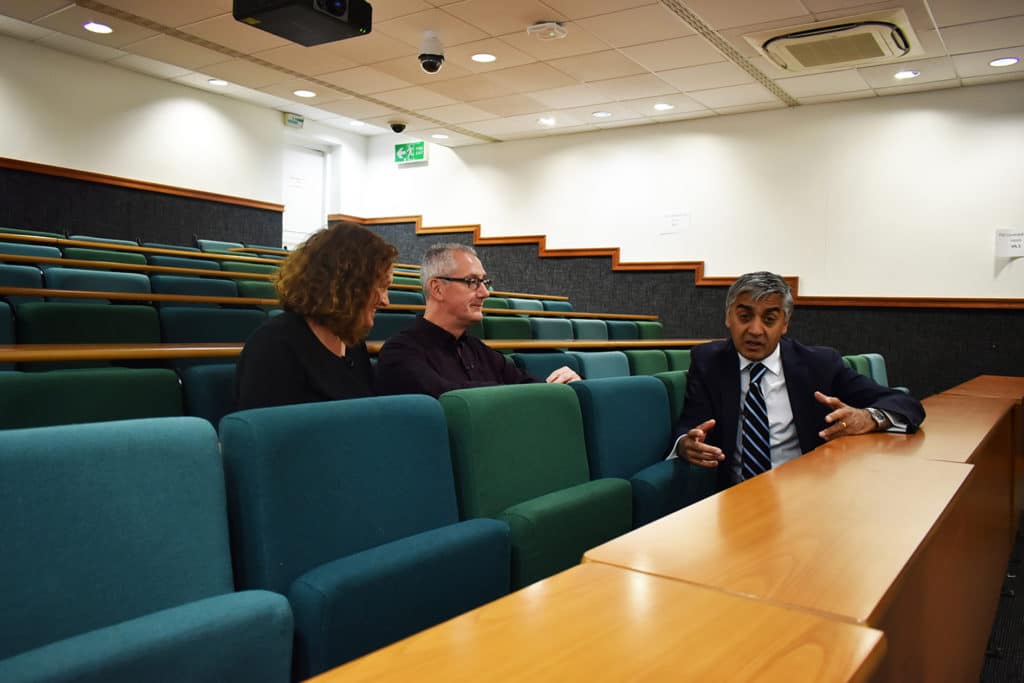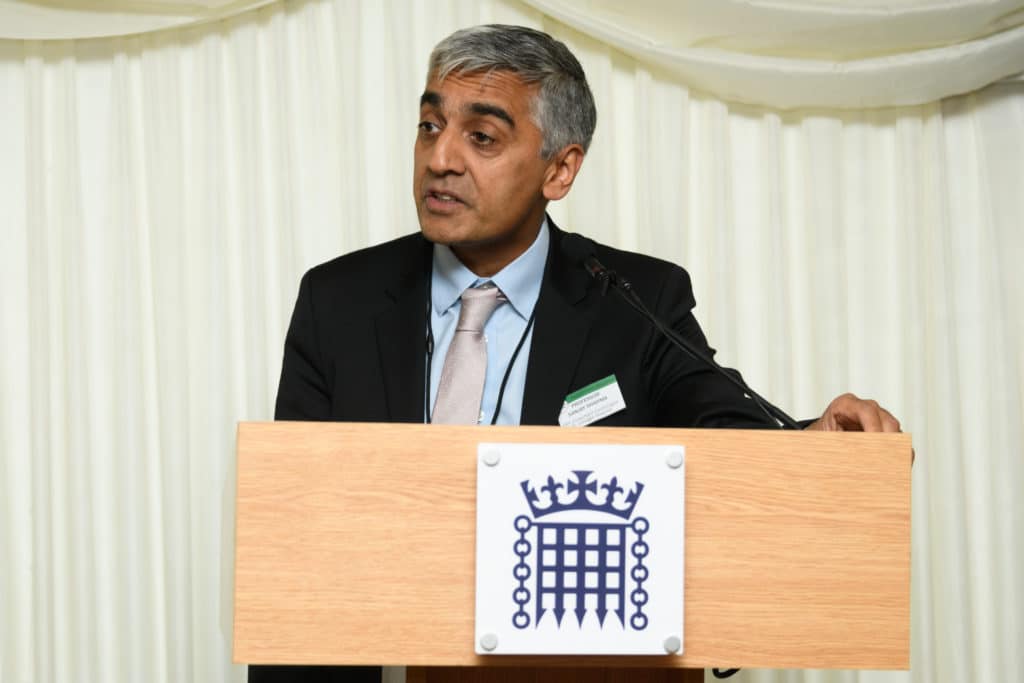There won’t be many – if any! – CRY supporters and stakeholders who aren’t already familiar with our Consultant Cardiologist, Professor Sanjay Sharma.
Not only has Prof Sharma been an integral part of the fabric of our history for the past 25 years, overseeing (and growing) our pioneering screening programme and supervising and mentoring our Research Fellows, he has also taken on a range of impressive posts such as Medical Director of the London Marathon, Team GB (ahead of the 2012 Olympics) and Cardiology Advisor to the LTA and English Institute of Sport (EIS).

In the words of CRY’s Founder Alison Cox MBE (who first identified Prof Sharma’s early commitment to CRY’s vision back in 1996 and who has remained firm friends and one half of the ‘dynamic duo’ ever since), “Sanjay is simply superhuman” (but, as we all know, is far too modest to entertain such an idea!).
Last month (Saturday May 16) should have seen the second CRY Family Research Day, following the resounding success of the inaugural event held at St George’s University (the ‘home’ of CRY’s screening and research programmes) in May last year.
Prof Sharma played a key role in developing this day for those CRY Representatives who were keen to gain a clearer understanding about the importance of our research. Not only did he deliver the keynote speech to a packed auditorium of families and supporters, he then chaired a busy agenda of presentations all day from his fellow cardiologists and researchers and even found time (during his lunch hour!) to take part in filming on behalf of CRY for the UK-wide, “Made at Uni” initiatives!
Unfortunately, due to current social distancing restrictions, the 2020 Family Research Day has been postponed… so CRY felt there was no better opportunity for Alison Cox to tell us a little bit about how Professor Sharma became so involved and so intrinsically linked to CRY;
“From the first time I met Sanjay in 1996 – then, in the final stages of his training to be a Cardiologist under Professor Bill McKenna – I was astonished at his interest in CRY and his understanding of our ambitious goals, even though we were such a new, small charity. He was keen to learn as much as he could and wanted to understand more about the terrible impact on families and sense of desolation caused by a young sudden cardiac death.
“CRY’s mission has always been to endeavour to reduce suffering and one of our first goals was to create events that brought bereaved families together and which gave them an opportunity to talk about their loss and share the way that they tried to manage their suffering. They often mentioned how ‘clinical’ the doctors they dealt with could be, and wished it were possible for them to be something other than the ‘aloof’ healthcare professional they sometimes seemed to be.
“Our first Bereavement Support Day was held at the Institute of Child Health. I thought it would be an excellent opportunity for families to meet a ‘sensitive’ cardiologist and asked Sanjay if he would be a speaker, to talk about his feelings during a consultation with a ‘CRY family’. Although he agreed to do so, he called me several times beforehand, concerned about the tough topic he would be addressing, worried whether he would be able to appropriately articulate his feelings.
“In fact, his speech was incredible. He told of how sometimes he would find an excuse to leave the room for a minute because he had become so moved by the details of the tragedy he was listening to and had needed to compose himself. He explained how deeply the young tragedies affected him and emphasised his commitment to explore every possible avenue to reduce the number of deaths and successfully treat those found to carry the condition.
“There were about 100 bereaved parents there that day who had all been tragically affected by the sudden death of a fit and healthy child. Whether it was because he was a father to two young daughters or that he just had an innate understanding of the pain they were experiencing, he showed a depth of compassion that you don’t often see in ‘high flying’ doctors. I was determined to have him as part of CRY’s team.
“Sanjay’s career then took him to King’s College Hospital and University Hospital, Lewisham, SE London. With his great love of sport and growing interest in studying the ‘athlete’s heart’ he was becoming increasingly involved with CRY, which included supporting the launch of our All Party Parliamentary Group (APPG), the 2002 Parliamentary Reception when Health Secretary Yvette Cooper announced a 3 year Government Grant for the development of our Bereavement Support Programme, and the pivotal Parliamentary Reception which revealed that a new chapter on cardiac arrhythmia was to be added to the National Service Framework thanks to CRY’s lobbying work.
“In 2008, he stood with Steve (then Director of Screening) and I on College Green outside the Houses of Parliament with a number of CRY families, a large megaphone and 12 huge silhouettes as we announced new statistics (analysed and accredited by Sanjay and his fellow researchers) which demonstrated for the first time that the number of young people dying suddenly from these specific cardiac conditions was 12 a week rather than the 8 that had been believed for over a decade.
“That same year also saw the opening of CRY’s Centre for Cardiac Pathology at the Royal Brompton Hospital (which 6 years later moved to St George’s with Professor Mary Shepard at the helm so that it could work in tandem with our centre there).
“On 21 October 2009, we were very proud to announce that CRY’s Consultant Cardiologist had been appointed Professor of Inherited Cardiovascular Disease and Sports Cardiology at St George’s Hospital, a position that he would be taking up on 2 February 2010. It was poignant that Sanjay would be returning to the hospital where he not only took his final exams to become a consultant, but where he first linked up with CRY and declared his interest in this complicated field of medicine.
“St George’s was also the first hospital in the UK to develop a family screening clinic after CRY’s donation of an echocardiogram facilitated the establishment of a specialist clinic in young sudden cardiac death, leading to entire families being able to be screened together after their tragedy. The centre combined three essential features of CRY’s mission: to eliminate young (35 and under) sudden cardiac death and offering specialist services for affected families, competitive athletes and the general population. It also provided a unique ‘one stop shop’ for young people to be screened for potentially life-threatening cardiac problems.
“From the start Sanjay had been very enthusiastic about our screening programme – something most cardiologists were often dismissive of. He recognised the hugely important opportunity it offered to both identify those who might be at risk (and to treat them and other siblings without delay), but also to build a Research Programme with CRY that soon became acknowledged internationally.
“We funded a £500,000 grant to develop CRY’s Research Programme with 4 new ‘fellows’ and a clinical team to provide an unprecedented insight into young sudden cardiac death through our growing screening programme. The plan became part of the exciting new generation of cardiologists that were dedicated experts in this field.

“ICAP’s Charity Day two-year grant enabled us to offer screening to all young people born in 1995 (the year that CRY was founded) across the South East. This formed the basis of the regular Saturday screenings which we still provide at St George’s to this day.
“Families already affected by sudden cardiac death were also given access to this clinic, dedicated to inherited cardiovascular disease and sports cardiology. The general population were able to access nationwide screening services through the rapidly developing mobile screening programme (co-ordinated from this Centre) with elite athletes attending the world-renowned CRY Centre for Sports Cardiology.
“All spearheaded by Professor Sanjay Sharma!
“The many other blogs in these series will also show the myriad events that Sanjay has played a critical role in over the years – from speaking on CRY’s behalf; forging relationships with organisations such as the Football Association and Premiership Rugby; presenting CRY funded research at international conferences; more than 300 academic papers published; participating in numerous national media interviews; continuing to oversee CRY’s screening programme; emphasising the importance of screening athletes; and supervising the training of future cardiac specialists.
“However, for me, the most important asset that Sanjay has (and has also emphasised to the doctors he trained who were so inspired by his achievements and aspired to his standards) is still the care and compassion that he feels is vital to give to the bereaved families as they arrive at St George’s for the first time, seeking answers and reassurance that other family members are not at risk.
“As we mark our 25th anniversary and look back over CRY’s milestones, I am convinced that we could only have achieved what we did with Sanjay’s commitment, loyalty and belief. Whilst other young doctors may have run away from our unwavering agenda and single-mindedness, he relished the challenge. He was as determined as we were to confront these tragedies and thrived on hitting the situation straight on.”





